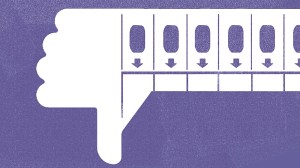Street Wise: Barakhamba Road, and a tomb that disappeared without a trace
It’s on Barakhamba Road that some of Delhi’s iconic buildings stand, including the National Museum of Natural History, Sapru House and Modern School.
 Historians say the tomb was built in the 15-16th Century, during Sher Shah Suri’s time. (Express photo by Tashi Tobgyal)
Historians say the tomb was built in the 15-16th Century, during Sher Shah Suri’s time. (Express photo by Tashi Tobgyal)
From a tomb that doesn’t exist anymore to an urban myth about every 12th streetlight on the stretch being fluorescent — the stories surrounding the origin of Barakhamba Road are plenty.
In the early 20th Century, Maulvi Zafar Hasan, an archaeologist with the Archaeological Survey of India (ASI), documented Barah Khamba as “probably a tomb, which has been given its name on account of the 12 pillars which support its roof.”
Across four volumes, Hasan documented monuments that dotted the city, and many which don’t exist anymore, including Barah Khamba, which he wrote was “400 yards to the east of Delhi Qutb Road at Raja ka Bazar”. Describing the 12 pillars, which support a vaulted concrete roof, he said that they were made of Delhi quartzite.
“There is no trace of the grave and this has probably been removed by the villagers who occupied the building for some time,” wrote Hasan, who felt the monument’s protection was “unnecessary”.
Interestingly, when Hasan was writing about Barah Khamba in May 1914, he noted that it was being used by a government official, who was part of the team planning New Delhi since 1911. He wrote: “It is being used as an office of an executive engineer of the third project division, and has been repaired, paved and whitewashed.”
Years later, Barah Khamba disappeared without a trace, and left behind a road named after its legacy. “The tomb was probably built in the 15th-16th Century, during Sher Shah Suri’s time. When Delhi was being planned, this monument must have served as a landmark, and maybe that’s why a road was named after it,” said Swapna Liddle, convenor, Indian National Trust for Art and Cultural Heritage, Delhi chapter.
About the mysterious disappearance of the monument, historian Sohail Hashmi pointed to the railway line that came up. “It was acquired for that purpose, and the village around it, also called Barakhamba village, was resettled elsewhere. It was located before the Ranjit Singh flyover, towards Connaught Place,” he said.
It’s on Barakhamba Road that some of Delhi’s iconic buildings stand, including the National Museum of Natural History, Sapru House and Modern School. “The name of the road is our only contact with the history of the place. It tells us not only about the monument it’s named after but also about the era, about the planning of New Delhi and the monument’s disappearance. This is an example of micro-history being recorded through a road sign,” said Liddle.
Apart from this look into the past, in 2003, an urban myth around Barakhamba Road emerged — one that is alive even after 16 years. “That year, light poles were being put up and people believed that the road was called Barakhamba because every 12th pillar had a fluorescent light, while the rest were yellow bulbs. It’s an urban legend,” said Hashmi.












